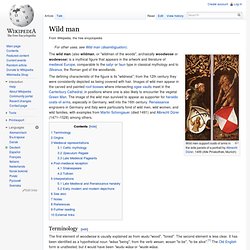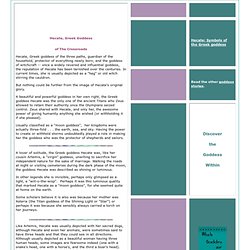

Wild man. Wild men support coats of arms in the side panels of a portrait by Albrecht Dürer, 1499 (Alte Pinakothek, Munich) Terminology[edit] The first element of woodwose is usually explained as from wudu "wood", "forest".

The second element is less clear. It has been identified as a hypothetical noun *wāsa "being", from the verb wesan, wosan "to be", "to be alive".[1] The Old English form is unattested, but it would have been *wudu-wāsa or *wude-wāsa. Late 15th century tapestry from Basel, showing a woodwose being tamed by a virtuous lady The term was usually replaced in literature of the Early Modern English period by classically-derived equivalents, or "wild man", but it survives in the form of the surname Wodehouse or Woodhouse (see Woodhouse family). Origins[edit] Figures similar to the European wild man occur worldwide from very early times. Pontus and his train disguised as wild men at the wedding of Genelet and Sidonia. Medieval representations[edit] Celtic mythology[edit] Shakespeare[edit]
HECATE GODDESS OF : Greek mythology. Hecate, Greek Goddess of The Crossroads. Hecate, Greek goddess of the three paths, guardian of the household, protector of everything newly born, and the goddess of witchcraft -- once a widely revered and influential goddess, the reputation of Hecate has been tarnished over the centuries.

In current times, she is usually depicted as a "hag" or old witch stirring the cauldron. But nothing could be further from the image of Hecate's original glory. A beautiful and powerful goddess in her own right, the Greek goddess Hecate was the only one of the ancient Titans who Zeus allowed to retain their authority once the Olympians seized control. Zeus shared with Hecate, and only her, the awesome power of giving humanity anything she wished (or withholding it if she pleased). Usually classified as a "moon goddess", her kingdoms were actually three-fold . . . the earth, sea, and sky. In other legends she is invisible, perhaps only glimpsed as a light, a "will-o-the-wisp". She knew what the rest of us did not. Singing Over the Bones. Mythic Reading Lists. The field of mythic fiction consists of contemporary works that draw on the timeless themes and symbolism of world mythology, medieval romance, folklore, fairy tales, and the oral stoytelling tradition.

Mythic fiction is set in the modern (or historical world), not in a far–off Nevernever land. But it portrays a world infused with mythic archetypes, mystery, and magic. Works of mythic fiction can be found on the mainstream fiction shelves in the form of magic realism and surrealism, as well as in genre fiction, Young Adult fiction, and other parts of the bookstore. The following list contains 100 fine novels by 100 fine writers of contemporary mythic fiction. The books on our list range from charming, entertaining confections to powerful novels that rank among the best works of modern literature. For recommendations for younger readers, see Mythic Fiction for Young Adults by Julie Bartel. The Heritage of the Orkney Islands. The Wild Hunt. World Myths and Legends in Art (Minneapolis Institute of Arts) The Book of Daniel Although written in the first person, the author of the book of Daniel was actually a pious Jew living under the persecution of Antiochus Epiphanes, 167-164 B.C.2 To encourage his suffering fellow believers, he tells six stories, set in earlier days in Babylon just before and after the Persian conquest, which illustrate how faithful Jews, loyally practicing their religion, were enabled by divine aid to triumph over their enemies.

The memory of Nebuchadnezzar was still strong at the time of this writing because he had crushed two Jewish revolts and then had destroyed the temple in Jerusalem in 586 B.C.3 Nebuchadnezzar II ruled over the Babylonian empire from 605 to 562 B.C. WHERE THE WILD THINGS ARE? IN SEARCH OF THE WOODWOSE, EUROPE'S ELUSIVE MAN-BEAST. Captive wild man being tamed by virtuous woman - Swiss tapestry, late 1400s Homo sapiens was not the only species of human named and recognised by Linnaeus when publishing Systema Naturae, his revolutionary binomial system of zoological classification, in 1735.

Among several others was Homo ferus, the wild man, which according to Linnaeus was covered in hair, moved on all fours, was mute, and lived apart from H. sapiens in forests, hills, and mountains. Today, none of Linnaeus’s ‘other’ species of human is recognised by mainstream science. Bestiary depiction of European wild man Woodwoses (Albrecht Dürer, 1499) Linnaeus himself delineated various subcategories of Homo ferus, of which the most significant was Juvenis lupinus hessensis – ‘wolf boys’, or feral children.
Depiction of Mowgli, the wolf boy from Rudyard Kipling's Jungle Books, by Kipling's father, J Lockwood Kipling (1895) Famous statue of Romulus and Remus suckling a she-wolf Green man sculpture (Dr Karl Shuker) Homo ferus the quest for evidence and explanation. Rocky Road: Linnaeus. Linnaeus In the early 18th century, mushrooms were mushrooms.

Some were tasty, some were nasty and some would kill you, but they were all mushrooms. International Commission on Zoological Nomenclature. James Hillman. The Center for Story and Symbol, Joseph Campbell and Archetypal Psychology. King Arthur: History & Legend. The Heritage of the Orkney Islands. Norse Mythology for Smart People - The Ultimate Online Resource for Norse Mythology and ReligionNorse Mythology for Smart People.